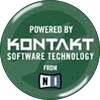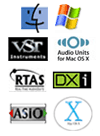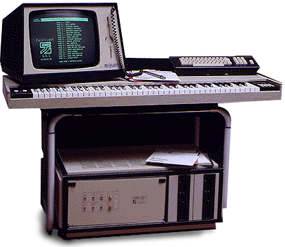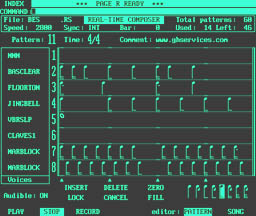|
Nostalgia demo 1
Nostalgia demo 2


|
 |
To say that the Fairlight
caused a sensation when it was released in 1979 would be something
of an understatement. There had never been a synthesiser like it.
There had never been a synthesiser as expensive either!
The basic model was a 'mere' £17,000 going up to £25,000
with all the options installed. In other words, this was not a synth
for ordinary folk. In fact, the kind of folk that did buy it were
well-heeled musicians like Stevie Wonder, Thomas Dolby, Trevor Horn,
the Pet Shop Boys, Vince Clark (Erasure) and Peter Gabriel.
In fact, Gabriel bought one of the first ever Fairlights
and was so impressed, his cousin, Steven Paine, set up a company
- Syco - to distribute it exclusively and I have fond memories of
going to Syco in London to get a demo. What I witnessed was (for
the time) just absolutely staggering and I spent the journey home
wondering how the hell I could ever raise the funds to buy one.
Of course, I couldn't and the Fairlight was sadly to remain a pipedream
for me. |
| Of course, most people associate the Fairlight with
sampling but it was actually a digital synthesiser first and foremost
that just happened to be able to do sampling as well. It could do
additive synthesis and you could (literally) draw waveshapes on
the CRT with the light pen.
It also had a sequencer and could be driven multi-timbrally
with a different sound for each of the eight voices.
It wasn't quite the same kind of sequencer we're used to today,
however - you had to 'type' your music in using Fairlight's own
MCL (Music Composition Language) - it was tedious but gave you precise
control over the music. |
| However, a software update
changed all that with the addition of Page R, the Real-time Composer
(right).
This allowed you to place notes (or 'hits' or 'beats')
in a more intuitive way (using the lightpen I seem to recall). Each
of the eight 'channels' represents a voice and with the sampling
facility, you could program 'acoustic' drum patterns. But let's
not get carried away here.... let's bear one thing in mind - the
sampling resolution in these early Fairlights was 8-bit with a bandwidth
not much higher than 11kHz! Let's just say that sparkling snares
and sizzling cymbals and hi-hats were not its greatest strength!
In fact, to be honest, in hindsight, sampling quality
was pretty poor but that didn't stop a whole industry building up
around the Fairlight - there were companies that would hire one
out to you for like £1,000 a day and agencies sprang up offering
the services of Fairlight programmers who could earn serious money
running the thing for producers who just had to have the new toy
on their records. |

Screen shot by Greg Holmes |
As you can see from the screen shots, the
CRT was typical of the day - advanced even - and reminds me of the
early Amstrad word processors. Filenames were short (DOS type 8.3)
and cryptic - outstanding at the time but a far cry from what we're
used to today! |

Screen shot by Greg Holmes |
The user interface was driven
by a paging system with each page representing a logical sub-section
of the Fairlight's operation.... I guess these are now referred
to as 'modes'.
On boot up, you'd be presented with Page 1 (left) where
you could access the various pages from the QWERTY keyboard.
As you can see, sampling was not uppermost in the original
user interface being relegated to Page 8 of the overall operating
menu.
You can see as well that Page R - the page that probably
did much to establish the Fairlight as a sequencing workstation
- is right down there at the bottom... almost as an afterthought...
which it was!
But however quaint this all may seem nowadays, you have
to remember that at the time, this was ground breaking, revolutionary
stuff... nothing like it had ever been seen before. |
| The Fairlight really did seem like a glimpse into the
future of music making which, of course, it was - the effect the Fairlight
had on the contemporary music industry just cannot be underestimated
and its invention is arguably as significant as Robert Moog's original
synthesisers or the invention of the electric guitar! |
But the Fairlight wasn't just a hit on records - it
also featured extensively on many science and music orientated TV
programmes and heralded as the future of music and much like the
Moog synthesiser became a household name, so too did the Fairlight.
And rightly so... it was the first ever sampler and it was the first
ever 'workstation' and despite its limitations, it deserves a reverential
place in music history because it literally changed the face of
music as we knew it then and now.
Nostalgia contains all the well-known Fairlight sounds
including:
| ARR1 |
Breathy vocals used by Tears For Fears, Thomas
Dolby and countless others |
| ORCH5 |
Arguably the most famous sample ever |
| SWANEE |
Breathy pan pipe sound |
| PIZTWANG |
Deep piano-based bass sound used by Peter Gabriel |
| MARIMBA |
As used by Peter Gabriel (and ushering in the
whole 'wold music' era) |
| Various strings |
|
| And more.... |
|
|
For the record, I have - with
permission - plundered Greg Holmes extremely informative Fairlight
website for screen shots. You should visit it for more in-depth information
about the inner workings of this classic instrument: http://www.ghservices.com/gregh/fairligh/
Greg's excellent site also offers examples of some of
the Fairlight's sounds.
For those who may be interested,
you can download the original IIx brochure below. Our thanks to Louis
van Dompselaar for taking the trouble to scan his crumpled old copy
of it and send it to us. It's quite an interesting read! Fairlight
brochure (1.5Mb - PDF) |
|

